
Easter Wings is a poem by George Herbert which was published in his posthumous collection, The Temple (1633). It was originally formatted sideways on facing pages and is in the tradition of shaped poems that goes back to ancient Greek sources.

Easter Wings is a poem by George Herbert which was published in his posthumous collection, The Temple (1633). It was originally formatted sideways on facing pages and is in the tradition of shaped poems that goes back to ancient Greek sources.
The Renaissance revival of interest in ancient Greek poetry brought to light a few poems preserved in the Greek anthology in which the shape of the lay-out mimics the poem's sense. Among these was one in the shape of wings by Simmias of Rhodes. The poem is in the form of an allusive riddle whose subject is Eros, the god of love, but where the only hint of his wings is contained in the adjective referring to him, “swift-flying”. [1] These poems and their like were later imitated in Renaissance Neo-Latin verse [2] and the fashion then spread to vernacular literatures as well.
Stephen Hawes was the first English author to take this up in his intricate “A pair of wings” in about 1500. [3] But whereas the Classical example is shaped so that the wings rise and fall from the centre, as happens also in Herbert's “Easter Wings”, Hawes makes the lines diminish to wing tips in a crescent from the wider body of the poem's centre and backs it up with an alternative short poem lying behind the main text.

Herbert's poetry may be referred to the 16th century tradition of the emblem, which combines a motto with a simple symbolic picture and poetic explanation, [4] as well as, in the case of “Easter Wings”, the example of Greek shaped poetry. The poem's two-stanzas were originally formatted sideways across opposite pages on its first publication, making the likeness to two sets of wings more obvious. [5] Another pattern poem appearing near the start of his collection, The Temple, was "The Altar".
There were three other poems in the shape of wings published later than Herbert's. One may have been written about the same time, but as in Herbert's case was not published until after the author's death. It appeared as a lyrical insert towards the end of William Bosworth’s The Chaste and Lost Lovers (1651). [6] In the case of Patrick Carey’s “O that I had wings like a dove”, the poem was written about 1651 but not printed until 1820. [7] The 4-stanza poem is in a radically different form, with long lines at the beginning, middle and end, punctuated by shorter lines dividing them within the stanza.
Christopher Harvey’s The Synagogue, originally published anonymously in 1640, announced itself on the title page to be “in imitation of Mr George Herbert”. [8] Their kinship was so close that subsequently the two collections were often published together. The six wing-shaped stanzas of Harvey's “Cordis Volatus” are on the same theme as Herbert's but lack his subtlety of treatment. [9]
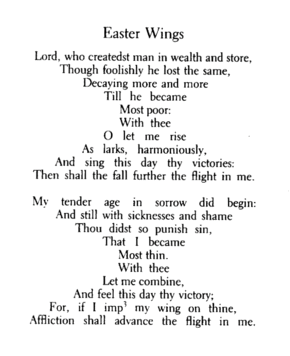
"Easter Wings" is a religious meditation that focuses on the atonement of Jesus Christ. [10] Its celebration of bodily and spiritual resurrection draws its theme from 1 Corinthians 15, and it is specially notable that the word ‘victory’ found in the Biblical text is repeated in both stanzas of the poem. [11] As well as the poem's being emblematic of the redeemed soul overall, the expansion and contraction of the lines imitates the meaning of the words. Thus in the first stanza the line “O let me rise” occurs as the wing unfurls again and is answered by the theme of climbing in the second. There is also similar imitative wording at the centre of both stanzas, “Till he became/ Most poore” in the first being answered by “That I became/ Most thinne” in the second.
There was a reaction against this kind of writing in Augustan literature, with Herbert's poetry singled out as the most recognisable example of 'false taste'. In John Dryden’s satire “Mac Flecknoe”, the new monarch of literary Nonsense is dismissed to pursue Baroque invention in
And in case any doubt should remain, Joseph Addison went on to name the author that Dryden had in mind in an essay in The Spectator . It was Herbert, he maintained, who had helped revive “this obsolete kind of wit”. [13] That disapproval was to remain in place until the revival of critical interest in the Metaphysical Poets at the start of the 20th century. Since then Herbert's typography has been recognised as a significant adjunct to the poem's meaning. [14] [15]

Poetry, also called verse, is a form of literature that uses aesthetic and often rhythmic qualities of language − such as phonaesthetics, sound symbolism, and metre − to evoke meanings in addition to, or in place of, a prosaic ostensible meaning. A poem is a literary composition, written by a poet, using this principle.
A quatrain is a type of stanza, or a complete poem, consisting of four lines.

John Dryden was an English poet, literary critic, translator, and playwright who in 1668 was appointed England's first Poet Laureate.
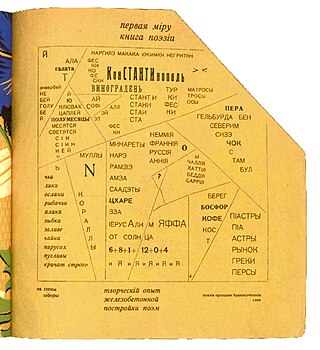
Concrete poetry is an arrangement of linguistic elements in which the typographical effect is more important in conveying meaning than verbal significance. It is sometimes referred to as visual poetry, a term that has now developed a distinct meaning of its own. Concrete poetry relates more to the visual than to the verbal arts although there is a considerable overlap in the kind of product to which it refers. Historically, however, concrete poetry has developed from a long tradition of shaped or patterned poems in which the words are arranged in such a way as to depict their subject.
Richard Flecknoe was an English dramatist, poet and musician. He is remembered for being made the butt of satires by Andrew Marvell in 1681 and by John Dryden in Mac Flecknoe in 1682.
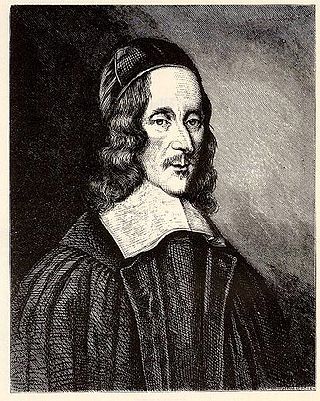
George Herbert was an English poet, orator, and priest of the Church of England. His poetry is associated with the writings of the metaphysical poets, and he is recognised as "one of the foremost British devotional lyricists." He was born in Wales into an artistic and wealthy family and largely raised in England. He received a good education that led to his admission to Trinity College, Cambridge, in 1609. He went there with the intention of becoming a priest, but he became the University's Public Orator and attracted the attention of King James I. He sat in the Parliament of England in 1624 and briefly in 1625.

"Ode to a Nightingale" is a poem by John Keats written either in the garden of the Spaniards Inn, Hampstead, London or, according to Keats' friend Charles Armitage Brown, under a plum tree in the garden of Keats' house at Wentworth Place, also in Hampstead. According to Brown, a nightingale had built its nest near the house that he shared with Keats in the spring of 1819. Inspired by the bird's song, Keats composed the poem in one day. It soon became one of his 1819 odes and was first published in Annals of the Fine Arts the following July. The poem is one of the most frequently anthologized in the English language.

The term Metaphysical poets was coined by the critic Samuel Johnson to describe a loose group of 17th-century English poets whose work was characterised by the inventive use of conceits, and by a greater emphasis on the spoken rather than lyrical quality of their verse. These poets were not formally affiliated and few were highly regarded until 20th century attention established their importance.

The Sapphic stanza, named after Sappho, is an Aeolic verse form of four lines. Originally composed in quantitative verse and unrhymed, since the Middle Ages imitations of the form typically feature rhyme and accentual prosody. It is "the longest lived of the Classical lyric strophes in the West".

"Ode on a Grecian Urn" is a poem written by the English Romantic poet John Keats in May 1819, first published anonymously in Annals of the Fine Arts for 1819.
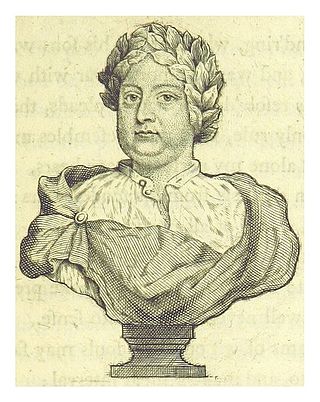
Mac Flecknoe is a verse mock-heroic satire written by John Dryden. It is a direct attack on Thomas Shadwell, another prominent poet of the time. It opens with the lines:

"A Prayer for my Daughter" is a poem by William Butler Yeats written in 1919 and published in 1921 as part of Yeats' collection Michael Robartes and the Dancer. It is written to Anne, his daughter with Georgie Hyde Lees, whom Yeats married after his last marriage proposal to Maud Gonne was rejected in 1916. Yeats composed the poem while staying in a tower at Thoor Ballylee during the Anglo-Irish War, two days after Anne's birth on 26 February 1919. The poem reflects Yeats's complicated views on Irish Nationalism, sexuality, and is considered an important work of Modernist poetry.
The following outline is provided as an overview of and introduction to poetry:
An altar poem is a pattern poem in which the lines are arranged to look like the form of an altar. The text and shape relate to each other, the latter usually giving added meaning to the poem itself. The tradition of shaped poetry goes back to Greek poets writing in Alexandria before the Common Era but most examples date from later and were written by European Christian poets during the Baroque period.
The Passion is an unfinished ode by John Milton that was possibly written in 1630 and was first published in 1645 or 1646. The poem connects Christ's Crucifixion with his Incarnation. It is linked to two other poems of Milton: On the Morning of Christ's Nativity and Upon the Circumcision
Decasyllabic quatrain is a poetic form in which each stanza consists of four lines of ten syllables each, usually with a rhyme scheme of AABB or ABAB. Examples of the decasyllabic quatrain in heroic couplets appear in some of the earliest texts in the English language, as Geoffrey Chaucer created the heroic couplet and used it in The Canterbury Tales. The alternating form came to prominence in late 16th-century English poetry and became fashionable in the 17th century when it appeared in heroic poems by William Davenant and John Dryden. In the 18th century famous poets such as Thomas Gray continued to use the form in works such as "Elegy Written in a Country Churchyard". Shakespearean Sonnets, comprising 3 quatrains of iambic pentameter followed by a final couplet, as well as later poems in blank verse have displayed the various uses of the decasyllabic quatrain throughout the history of English Poetry.
Nationality words link to articles with information on the nation's poetry or literature.
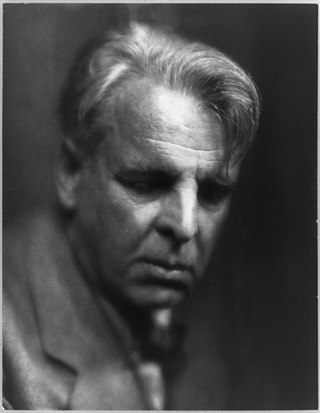
Blood and the Moon is a poem by Irish poet William Butler Yeats written in 1928 and published in the collection The Winding Stair in 1929 before being reprinted in The Winding Stair and Other Poems in 1933. Yeats composed the poem in response to the 1927 assassination of Kevin O'Higgins, the Vice-President of the Free State, whom Yeats had known personally. The poem contains many themes common in Yeats's poems from the 1920s including the "tower", a reference to Thoor Ballylee, which had been the title of a collection of works printed the year before "Blood and the Moon" was published, as well as the "gyre" which had been a major focus of his 1920 poem "The Second Coming".
The Threnodia Augustalis is a 517-line occasional poem written by John Dryden to commemorate the death of Charles II in February 1685. The poem was "rushed into print" within a month. The title is a reference to the classical threnody, a poem of mourning, and to Charles as a "new Augustus". It is subtitled "A Funeral-Pindarique Poem Sacred to the Happy Memory of King Charles II," and is one of several poems on the subject published at the time.
"The Altar" is a poem by the Welsh-born poet and Anglican priest George Herbert, first published in Herbert's collection The Temple. As an example of shaped poetry, its popularity in the 17th century is attested by several imitations and a musical setting.